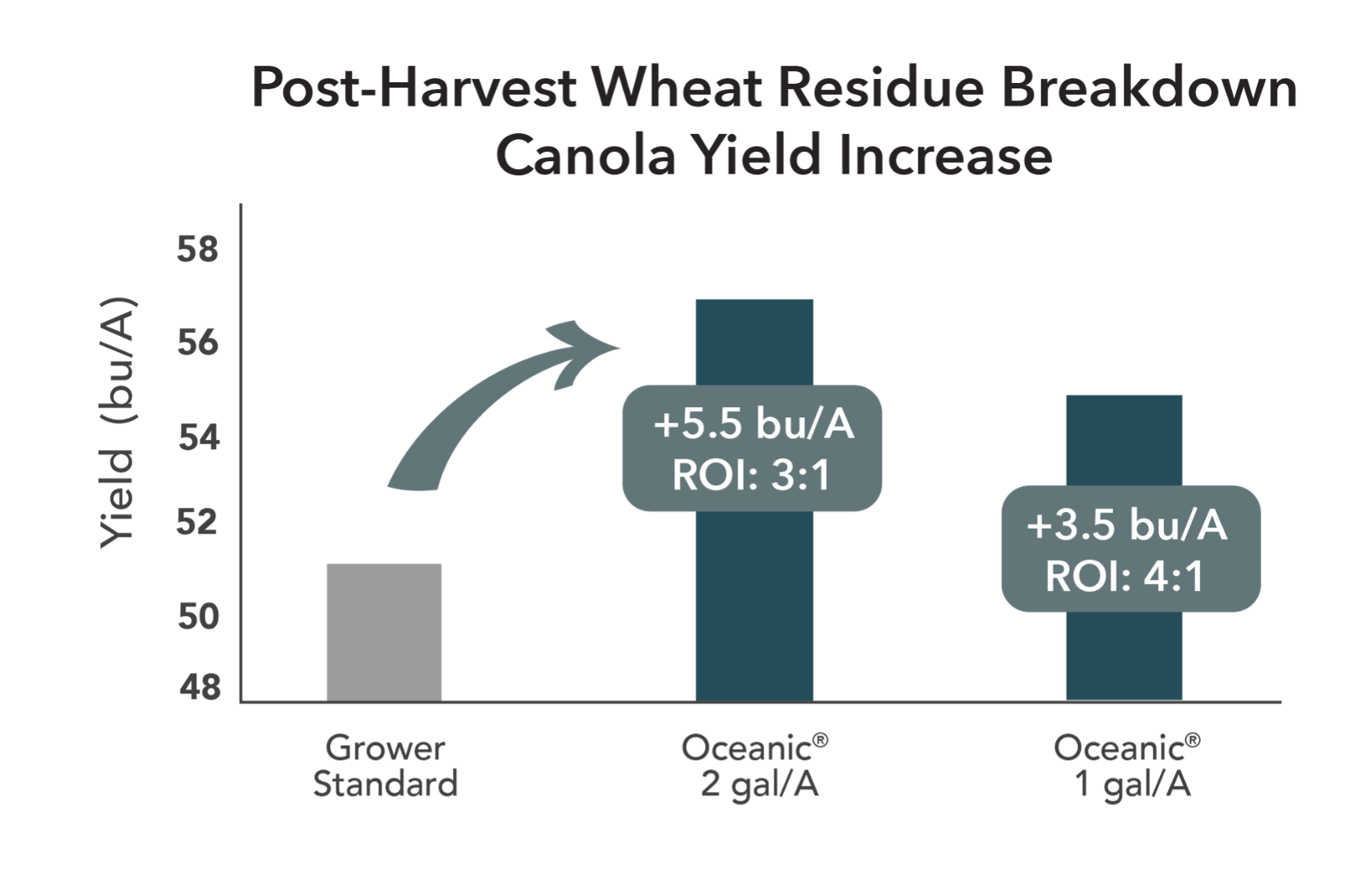Benefits of Post-Harvest Residue Management
Aug 05 2025
Tidal Grow® Oceanic® Unlocks Nutrients, Improves Soil Health, and Optimizes Planting
Tidal Grow® Oceanic® Unlocks Nutrients, Improves Soil Health, and Optimizes Planting
Post-harvest may look like a break, but underground biology is still at work. Managing crop residue after harvest is essential—while soil temperatures cool, biological activity slows but never stops. This window offers a prime opportunity to accelerate decomposition, reduce biomass, enhance nutrient cycling, and stabilize soil structure before winter sets in. Post-harvest residue management is especially important for crops like corn, wheat, canola, and soybeans, where the carbon-to-nitrogen ratio impacts how quickly residue breaks down. Without proper microbial support, nutrients can become locked up, reducing seedbed quality and delaying spring planting.
That’s where Tidal Grow® Oceanic® and Oceanic® Organic can help. These cold-processed seafood hydrolysate fertilizers supply bioavailable amino acids that activate microbial life in the detritusphere—the zone around decomposing residue. By kickstarting these biological processes, Tidal Grow® Oceanic® and Oceanic® Organic help convert residue into stable organic matter, enhancing nutrient availability and setting the stage for healthier soil and improved yields.
5 Benefits of Implementing a Residue Management Strategy This Fall for Stronger Spring Growth
Feeding soil microbes after harvest unlocks multiple benefits—from enhancing nutrient flow and aggregating soil to improving planting conditions and opening doors to carbon credits or conservation incentives. Effective residue management at this stage fuels microbial activity and prevents nutrient tie-up at a critical time in the crop cycle.
1. Fields Are Ready Sooner
Starting residue breakdown in the fall lets growers access the fields earlier, cut down on spring tillage, reduce soil compaction, and create warmer, drier seedbeds—so growers can plant sooner and more efficiently come spring.
2. Nutrient Availability is Boosted
Residue decomposition releases locked nutrients like nitrogen and phosphorus, enhancing crop vigor, reducing fertilizer needs, and improving nutrient timing for better crop uptake.
3. Soil Quality and Resilience Are Improved
Tidal Grow® Oceanic® feeds soil microbes, supporting fungi and bacteria that strengthen soil structure and improve tolerance to drought, nutrient variability, and temperature changes. These improvements also promote stable organic matter formation and long-term soil function.
4. Reduced Till and No-Till Systems Are Enabled
By encouraging natural soil aggregation and moisture retention, fall microbial activity reduces the need for intensive spring tillage, helping preserve topsoil and consistent yields.
5. Carbon Credits and Conservation Incentives Become Available
Practices that build soil, reduce tillage, improve nutrient cycling, and support microbial communities may align with environmental programs that focus on rewarding soil health initiatives and reducing environmental impact. Utilizing fall soil-building inputs like Oceanic® and other climate-smart practices may be rewarded with conservation payments or carbon credits by these programs.
The Impact of High Carbon-to-Nitrogen Residue on Soil and How to Respond
The quantity, type, and decomposition rate of crop residue left behind in the field can all play a significant role in how the soil should be prepared for planting in the spring. Crops like wheat, corn, canola, and soybeans all leave behind different carbon-to-nitrogen ratios—wheat is about 91:1; corn is 73:1; canola is 72:1; and soybeans are 53:1. The higher the ratio, the more carbon-heavy and nitrogen-deficient the material, making it challenging for the microbes to process.
In scenarios where high C:N residue is left untreated, microbial communities become nitrogen-limited, delaying nutrient release and causing cooler, less uniform soils come planting season. Fortunately, growers can get ahead of these issues with a fall application that helps feed the microbes and improve soil structure. Tidal Grow® Oceanic® and Oceanic® Organic’s seafood-based nutrients supply amino acid-rich compounds that help balance these C:N ratios by energizing the microbial populations that support soil aggregation, mineralization, and disease suppression. When applied before the freezing temperatures that come with winter, Oceanic® can help keep microbes functioning long enough to drive meaningful residue conversion, preparing fields for a productive and efficient spring.
Fall Soil Health Support with Tidal Grow® Oceanic®
When applied in the fall, Tidal Grow® Oceanic® and Oceanic® Organic can help improve yield and ROI—up to 4:1—by feeding soil biology, unlocking nutrients from lingering residue, and reducing the need for intensive tillage in the spring. This creates a more consistent seedbed, better seed-to-soil contact, and stronger early crop development.
By delivering a powerful blend of cold-processed seafood hydrolysate, rich in amino acids, amino sugars, omega-3s, and trace minerals, microbes responsible for nutrient cycling and soil structure can thrive. With a 2-1-0 NPK profile, Oceanic® supports nitrogen availability while helping release micronutrients in high C:N residue systems where early nutrient stress is common.
Apply 1 to 2 gallons per acre after harvest and before the first local freeze. Tidal Grow® Oceanic® and Oceanic® Organic work with most fall equipment; if growers are combining with other inputs, a quick jar test can confirm compatibility. For best results, even coverage is essential, and growers should avoid frozen or saturated soils to protect microbial function. Tailoring your offerings with an agronomist’s advice ensures they will work in harmony with your growers’ crops, equipment, and soil.
Proven ROI from Fall Applications
In high-residue systems, Tidal Grow® Oceanic® and Oceanic® Organic have been proven to improve nutrient cycling, yield, and soil structure. In North Dakota wheat residue trials ahead of canola planting, 2 gallons per acre of Oceanic® helped increase yield by 5.5 bushels per acre, cut residue mass by 54%, and delivered a 3:1 return on investment—all while reducing the need for tillage.

Smarter Fall Applications, Stronger Soil
Post-harvest is your growers’ window to start a system for stronger returns. Tidal Grow® Oceanic® jumpstarts the biology that breaks down residue, builds soil structure, and sets up smoother spring planting. Supporting microbial activity before winter gives growers’ soil a head start—and positions them for future payoffs.
To learn more about integrating Tidal Grow® Oceanic® and Oceanic® Organic into your retail offering or agronomic strategy, visit tidalgrowag.com.
